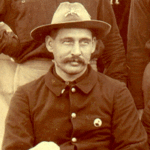 About the author: John Henry Asendorf (born Johann Heinrich Asendorf, August 27, 1863 — April 9, 1953). Pennsyvania Volunteer who served as a Private in the Spanish-American and Filipino-American War. From the original website, an extract from Genealogical & Personal History of Fayette County Pennsylvania by John W. Jordan & James Hadden vIII 1912, Lewis Historical Publishing Co., NY, pp. 693-695:
About the author: John Henry Asendorf (born Johann Heinrich Asendorf, August 27, 1863 — April 9, 1953). Pennsyvania Volunteer who served as a Private in the Spanish-American and Filipino-American War. From the original website, an extract from Genealogical & Personal History of Fayette County Pennsylvania by John W. Jordan & James Hadden vIII 1912, Lewis Historical Publishing Co., NY, pp. 693-695:
John Henry, son of Albert H. and Julia (Hageman) Asendorf, was born in Bremen, Germany, August 27, 1863. He received a good education in the public schools of Bremen, and on arriving at suitable age began learning the blacksmith’s trade. He continued two years, then in 1879 came to the United States, landing in Baltimore, Maryland. After a short stay there he came to Fayette county, Pennsylvania, but after two years’ residence, returned east to Bayonne, New Jersey, where for eight years he was engaged in the butcher business. In 1891 he again came to Fayette county. In 1898 he enlisted in Company C, Tenth Regiment, Pennsylvania Volunteers, for the war against Spain. On his return with his regiment he settled in Uniontown, where he has ever since resided, engaged in a very successful butcher business. Is a Democrat in politics; served as school director of North Union township, Fayette county. Member of Christian church, also Knights of Malta and Heptasophs.
In addition,
Following the war, he returned to Uniontown and evidently took up his butcher’s business again. He served as Commander of the De La Loma Post 15 of the Veterans of Foreign War and belonged to the Daniel M. Bierer Camp 103 of the United Spanish War Veterans in Uniontown…
…Around roughly 1935, the entire Asendorf family moved to Toledo, Ohio. There he was a member of Egbert Camp 10 of the USWV…
According to Find A Grave he died on April 9, 1953 and is buried in Toledo Memorial Park, Sylvania, Lucas County, Ohio.
About the diary: As related by John P. Asendorf, the author’s great-grandson,
During his service from May 8, 1898 to August 21, 1899 he kept a diary. The diary is in four volumes which were snatched from their demise when my father died. As we were cleaning out his home in 1993, we found an old 40-gallon garbage bag filled with stuff of my grandfather’s: cancelled checks; tax returns; junk promotions for commemorative plates and collectible coins; old banks statements. My dad must have scooped this junk from a drawer after my grandfather died in 1979. It is likely dad intended to go through the bag at a later date but never got around to it. Thinking the bag to be filled with nothing of any importance, I set the bag aside to be dragged to the trash. As I picked up the bag to throw it away, I felt a sudden compulsion to go through the bag before tossing it. Inside the bag amidst all this junk there was only one thing of any importance, the diary. By 1993, no one in the family even knew that they existed. It was quite a find.
For years I held onto the diaries, keeping them safe and secure but not really anything else. In 2002 I decided to start transcribing the diaries during my free time. I finished typing the diaries into a text editor around while at Ft. Campbell, KY in 2006 and decided I needed a more permanent place and way to store it.
The Philippine Diary Project is grateful to Mr. John P. Asendorf for permission to reproduce the diary without restrictions, as well as for use of the author’s photo. The original site, which contains a great deal of additional information on the author and his times, can be accessed at The War Diary of John Henry Asendorf. The diary can also be found in the Pennsylvania Volunteers in the Spanish-American War 1898-1899 website. The entries, in many instances, have double entries: the original, with the author’s original spelling retained, and, when available, John P. Asendorf’s modern transcription of the the entries, which we reproduced in italics.
For purposes of relevance, we have not included the earlier portion of the diary which deals with Asendorf’s enlistment and initial training in the United States. In The Philippine Diary Project, we begin the Asendorf diary on May 24, 1898, with his arrival in Oakland, California en route to San Francisco. The last entry included in The Philippine Diary Project is July 1, 1899, when Asendorf’s ship, the U.S.S. Senator, weighed anchor in Manila Bay.
The only editing done by the Philippine Diary Project to these modern transcriptions is to correct, when possible, the Philippine place-names, and one or two small issues of spelling or continuity. All of these are indicated by being in underlined italics.